Waterlogged Lawn Repair: Turf Maintenance for Wet Soil
Are you struggling with a waterlogged lawn?
The UK is known for its wet weather, especially during autumn and winter. This can leave your lawn feeling soft and spongy underfoot. Often, the water may even pool visibly on the surface.
Regular waterlogging can cause a range of problems, from algae and moss to fungal diseases.
Fortunately, there are steps you can take to help your lawn recover and prevent it from happening again in the future. However, if your soil is very poor or there’s a lot of concrete underneath, some water may still collect during very wet winters.
From aeration and top dressing to effective moss control, a few simple maintenance practices can make a big difference.
Why Is My Lawn Waterlogged?
According to the RHS, ‘Soils become waterlogged when water is unable to drain away. This leaves no air spaces in the saturated soil, and plant roots literally drown’. As a result, your lawn may develop bare patches, which can then be taken over by weeds, moss, algae, lichens, liverworts, and diseases. Not only will these make your lawn look unkempt, but they will also make it weaker and can give it a sticky, slippery feeling when walked on. In extreme cases, your grass may even die.
A waterlogged lawn is usually caused by a few main issues: compacted soil, clay soil, or long periods of bad weather.
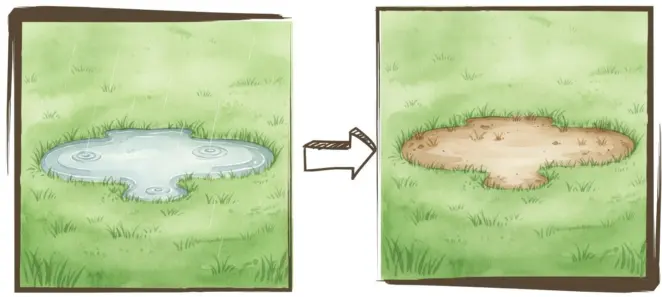
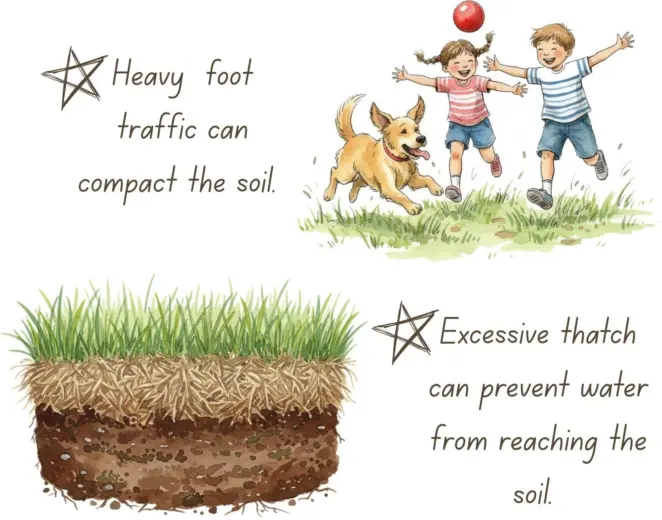
Compaction and Thatch
Your lawn has probably seen a lot of heavy foot traffic over the summer. This can compact the soil, making it harder for water to drain properly and leading to a waterlogged lawn. Other ways in which soil can become compacted include walking on a wet lawn or using heavy machinery.
Thatch works in a similar way. It is made from dead organic matter, such as old grass and moss. A thin layer can help the lawn to retain moisture and act as an insulation layer, protecting the grass against extreme temperature changes. However, a layer thicker than half an inch can act like a barrier, blocking water from reaching the soil and negatively impacting your lawn’s drainage.
The Clay Factor (Heavy Soil)
If your lawn often gets waterlogged, you may have clay soil in your garden.
There are three main types of soil across the UK: sandy, loam, and clay soil. Sandy soil drains very quickly, so it barely ever gets waterlogged. Loam soil is a mixture of sandy and clay soil, draining more slowly and needing a lot of rainfall before it becomes waterlogged.
Clay soil, on the other hand, is dense with tiny particles, leaving very little space for air and water to pass through. As a result, it gets waterlogged easily and can potentially flood your garden during periods of wet weather. It’s also more prone to compaction when walked on, especially when wet.
To learn more about different soil types, read our ‘Does Soil Type Affect Turf Laying?’ blog.
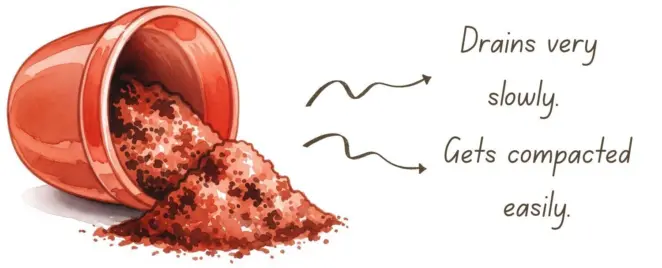
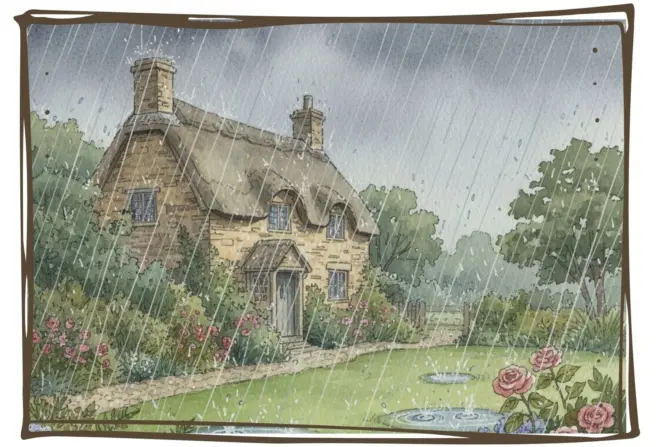
Just Bad Weather
Even well draining lawns can become waterlogged after intense rainfall, especially in low or uneven areas.
If your garden is located at the bottom of a hill, it may also be more susceptible to water collecting.
This type of waterlogging usually doesn’t last very long but can still stress your grass.
Step-by-Step Fix: How to Repair a Waterlogged Lawn
Remember: walking on a waterlogged lawn will only make the problem worse, as it further compacts the soil. Only start repairs once the lawn has drained and is no longer waterlogged. You should also wait until the lawn is at least six months old before aerating and at least one year old before scarifying.
Step 1: Deep Scarification and Aeration to Break the Seal
To effectively tackle compaction and thatch, which are often the two main causes of a waterlogged lawn, you'll need to use a combination of two different lawn care techniques: scarification followed by aeration.
Scarification is used to remove excessive thatch and moss, while lawn aeration is the process of creating small holes in the ground to loosen compacted soil. It works best when done after scarifying your lawn because the soil is no longer blocked by excessive thatch, allowing better contact with the soil. However, these can also be performed separately if needed.
Apply a moss killer a week or two before scarifying to make removal easier.
Once this time has passed, mow your lawn so that the grass is about 1 inch high and then begin scarifying your lawn.
For smaller gardens, use a rake or manual scarifier and work in rows going up and down your lawn, pushing it a few millimetres into the soil. For larger gardens, a mechanical or electric scarifier is a better option.


Once this is done, it is time to aerate.
There are two main ways to do this: spike aeration and plug aeration.
Spike aeration pokes holes in the ground without removing any soil and can be done using a spike aerator or a garden fork.
Plug aeration, on the other hand, uses hollow tubes to remove small plugs of soil and is done using a hollow-tine aerator.
When aiming to improve a lawn’s drainage, the RHS recommends using a hollow-tine aerator, as it creates wider, deeper channels for water to drain and relieves compaction more effectively.
To aerate your lawn, push the tool about 4-5 inches into the soil and pull it out so the grass lifts slightly. Repeat this process every 6 inches over the whole lawn. For larger gardens, an electric or mechanical aerator is more efficient. Turn it on, set it according to your soil type and desired depth, then walk slowly across the lawn while it does the job for you.
To learn more, check out our 'Lawn Aeration and Scarification: The Ultimate Guide'.
Step 2: Corrective Top Dressing with Sand
After hollow-tining a lawn, you can fill the holes with a sandy top dressing. If you’ve ever wondered what to put on clay soil to improve drainage, this is one of the best solutions. This method works for all soil types, but it is especially beneficial for a clay soil lawn.
Sand particles are larger than clay, creating bigger air pockets in the soil. This allows more oxygen to reach the grass roots and lightens heavy clay soil, helping it absorb water more easily. As a result, sandy top dressing can fix a soggy lawn and prevent it from becoming waterlogged, especially when applied at least once a year.
For best results, spread the top dressing at 2–3 kilograms per square metre and work it into the aeration holes using the back of a rake. Using less than the recommended amount may not provide the full benefits, causing the issue to come back in the future, while using too much can cover the grass too thickly. This reduces the amount of sunlight and air it receives, which can stress the lawn.
Remember: top-dress only when the lawn is actively growing. A dormant lawn won’t be able to recover from the stress that a new layer of soil is causing, potentially leading to it dying entirely.

Step 3: Moss Removal and Control
Even after using moss killer and scarifying, moss can return if your lawn stays damp and shaded.
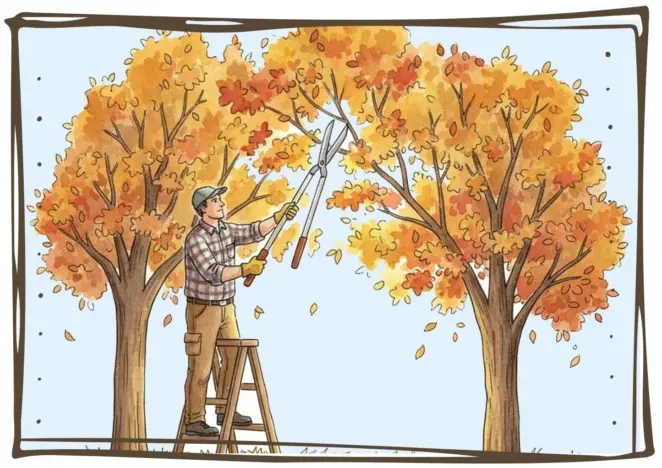
In the UK, sudden heavy rainfall or water pooling in low or uneven areas can create temporary waterlogged conditions, even on lawns that normally drain well. These damp conditions provide the perfect environment for moss. It can then compete with your lawn for water and nutrients, potentially preventing them from reaching the grass’ roots. This makes it harder for your lawn to recover from waterlogging, so controlling moss is essential if you want your lawn to bounce back quickly.
Alongside regular scarifying, aerating, and top dressing, make sure your lawn gets as much sunlight as possible. Pruning overhanging branches from trees and shrubs allows more light to reach the grass. This not only strengthens it to compete with moss but also helps the soil dry out faster, reducing the damp conditions moss thrives in.
For any moss that does reappear, you can use a high-iron treatment to manage regrowth.
Ongoing Turf Maintenance in Wet Conditions
The best way to stop your lawn from becoming waterlogged in the future is through long-term management and preventative care.
Scarify and aerate your lawn at least once a year. This prevents excess thatch from building up and keeps the soil from becoming too compacted so that your lawn is ready to handle any heavy rainfall. The best time to do this is in spring or early autumn, when the soil is warm and moist but not saturated, and the grass is actively growing.
Avoid using fertilisers that are high in nitrogen during the colder months. Instead, choose feeds designed for autumn and winter. These are high in potassium, which strengthens plant cell walls and helps the grass resist frost and disease. Nitrogen-rich fertilisers, on the other hand, encourage weak, leggy growth with shallow roots that will struggle to absorb water.

Try to avoid walking on your lawn when it’s wet. Wet soil compacts easily, which leads to poor drainage and blocks the grass from taking in the water and nutrients it needs. This makes the lawn more prone to waterlogging and slows its recovery. To avoid this, consider adding walkways or stepping stones and wait until the grass is dry before walking on it.
If you notice that your lawn tends to get waterlogged only in certain areas, it may be due to uneven ground. Dips and low points naturally act as collection areas for water, preventing proper lawn drainage. Consider levelling out your lawn to prevent this from happening and to allow for even drainage.


If waterlogging persists despite regular maintenance, consider installing a French drain. According to Ideal Home, ‘One of the best ways to floodproof your garden is to provide it with plenty of drainage, and a French drain is a go-to method for gardeners looking for an efficient system.’ Depending on your budget, you can install one yourself or hire a specialist. French drains are slightly sloped, allowing water to flow away from areas that are prone to flooding.
The Ultimate Solution: Installing a Specialist Turf
When it comes to having a lawn that can survive wet conditions, the quality of your turf makes all the difference.
A turf grown by specialists has had the right start in life, including being grown on carefully prepared soil and being mown and fertilised correctly to make it as resilient and dense as possible. As a result, a roll of turf has a strong root structure from the start, handling waterlogged conditions better and bounce back to health quicker when compared to a weak lawn that has not been properly cared for.
This is why, if you are planning to get a new lawn, make sure to use only trusted suppliers, like us. We have been in this industry for over two decades and know how to prepare our turf for long-term success.
If you already have a lawn, you can still benefit from specialist-grown turf by overseeding it with high-quality lawn seed mixes. Here at Online Turf, we offer our customers access to our exclusive Rye Gold Lawn Grass Seed, which is made from the same high-quality mix of perennial ryegrass and red fescue as our best-selling Rye Gold Turf. Perennial ryegrass is the main component of the mix, as it recovers quickly after damage, requiring minimal maintenance. For this reason, it is often used in gardens with heavy foot traffic, as well as for commercial or specialist use, such as on Wimbledon courts. Red fescue is the second key component of the seed blend, adding soft texture, shade tolerance, and the ability to thrive in low-maintenance environments.
To learn more about these products, check out our ‘Grass Seed: Why Choose Our New Product?' and 'Why Rye Gold Turf Is Great for Your Garden' blogs.

A waterlogged lawn isn’t just inconvenient. It can cause moss, algae, fungal diseases, and, in severe cases, dead grass. Regular maintenance, such as scarifying and aerating, helps your lawn recover and lowers the risk of future waterlogging.
Preventative care is just as important. Avoid walking on wet soil, manage low or uneven areas, and consider installing drainage solutions, such as a French drain, if needed.
If you’re planning a new lawn, choose turf from trusted suppliers to ensure it is strong, dense, and resilient. For existing lawns, overseeding can strengthen the grass and help it bounce back after wet conditions.
Are you ready to lay turf or overseed your garden? Explore our full product range today!
FAQs
Can I aerate a waterlogged lawn?
No, aerating a waterlogged lawn will only make the problem worse, as it will compact the soil further.
Instead, only aerate it once the lawn has drained.
Does spiking a lawn actually help drainage?
Yes, spiking a lawn creates small holes in the ground and loosens the soil, allowing water and nutrients to reach grass roots, improving drainage.
However, if your soil is severely compacted, instead of just spiking your lawn, try a hollow-tine aerator instead. It removes small plugs of soil, creating wider, deeper channels for water to drain and relieving compaction more effectively.
What kind of fertiliser should I use on a damp lawn?
You should be able to use both liquid and granular fertiliser on a damp lawn, but always check the instructions of your specific fertiliser before using it.
How can I prevent moss in my wet lawn?
Moss thrives in wet, shady conditions, so the best way to prevent it in your wet lawn is to improve drainage, increase the amount of sunlight your lawn receives, and maintain a good lawn care routine that keeps your grass strong and able to outcompete the moss.


